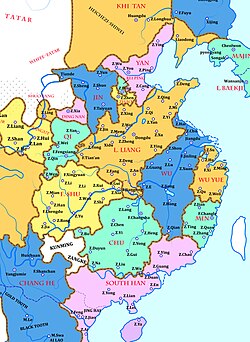Ma Chu
Chu 楚 | |||||||||
|---|---|---|---|---|---|---|---|---|---|
| 907–951 | |||||||||
 | |||||||||
| Capital | Changsha | ||||||||
| Common languages | Middle Chinese | ||||||||
| Government | Monarchy | ||||||||
| Prince/King | |||||||||
• 907–930 | Ma Yin | ||||||||
• 950–951 | Ma Xichong | ||||||||
| Historical era | Five Dynasties and Ten Kingdoms Period | ||||||||
• Became the State | 907 | ||||||||
• establishment of the Kingdom | 927 | ||||||||
• Ended by Southern Tang | 951 | ||||||||
| Currency | Silk, Cash coins (Iron) | ||||||||
| |||||||||
| Today part of | China | ||||||||
Chu (Chinese: 楚; pinyin: Chǔ), known in historiography as Ma Chu (馬楚) or Southern Chu (南楚), was a dynastic state of China that existed from 907 to 951. It is counted as one of the Ten Kingdoms during the Five Dynasties and Ten Kingdoms period of Chinese history.
Founding
[edit]Ma Yin was named regional governor by the Tang court in 896 after fighting against a rebel named Yang Xingmi. He declared himself as the Prince of Chu with the fall of the Tang dynasty in 907. Ma's position as Prince of Chu was confirmed by the Later Tang in the north in 927 and was given the posthumous title of King Wumu of Chu.
Territories
[edit]The capital of the Chu Kingdom was Changsha (Tanzhou).[1] The kingdom ruled over present-day Hunan and northeastern Guangxi.
Economy
[edit]Chu was peaceful and prosperous under Ma Yin's rule, exporting horses, silk and tea. Silk and lead coinage were often used as currency, particularly with external communities which would not accept other coinage of the land. Taxation was low for the peasantry and merchants.
Fall of Chu
[edit]After Ma Yin died the leadership was subject to struggle and conflict which resulted in the fall of the kingdom. The Southern Tang, fresh from its conquest of the Min Kingdom, took advantage and conquered the kingdom in 951. The ruling family was removed to the Southern Tang capital of Jinling. However, the following year, Chu generals rose against Southern Tang and expelled the Southern Tang expeditionary force, leaving the former Chu territory to be ruled by several of those generals called Wuping Jiedushi (武平军节度使) in succession.
Zhou Xingfeng (周行逢) ruled the Jiedushi from 956-962. In 956, Zhou Xingfeng executed and beheaded Pan Shusi (潘叔嗣), a general of the Southern Chu.[2][3]
During these post-Chu years of de facto independence, the center of power was usually at Lang Prefecture (朗州, in modern Changde, Hunan).
In 963, the Wuping Jiedushi ended and its territory was seized by the Song dynasty.
Rulers
[edit]| Temple Names ( Miao Hao 廟號; miaò haò) | Posthumous Names ( Shi Hao 諡號 ) | Personal Names | Period of Reigns | Era Names (Nian Hao 年號) and their according range of years |
|---|---|---|---|---|
| Did not exist | Wǔmù Wáng 武穆王 | Mǎ Yīn 馬殷 |
907–930 | Did not exist |
| Did not exist | None (commonly known as Prince of Hengyang (衡陽王; Héngyáng Wáng)) | Mǎ Xīshēng 馬希聲 |
930–932 | Did not exist |
| Did not exist | Wénzhāo Wáng 文昭王 | Mǎ Xīfàn 馬希範 |
932–947 | Did not exist |
| Did not exist | None (commonly known as Deposed Prince (廢王; Fèi Wáng)) | Mǎ Xīguǎng 馬希廣 |
947–951 | Did not exist |
| Did not exist | Gōngxìao Wáng 恭孝王 | Mǎ Xī'è 馬希萼 |
951 | Did not exist |
| Did not exist | Did not exist | Mǎ Xīchóng 馬希崇 |
951 | Did not exist |
Ma rulers family tree
[edit]| Ma Chu rulers family tree | |||||||||||||||||||||||||||||||||||||||||||||||||||||||||||||||||||||||||||||||||||||||||||||||||||||||||||||||||||||||||||||||||||||||||||||||||||||||||||||||||||||||||||||||||||||||||||||||||||||||||||||||||||||||||||||||||||||||||||||||||||||||||||||||||||||||||||||||||||||||||||||||||||||||||||||||||||||||||||||||||||||||||||||||||||||||||||||||||||||||||||||||
|---|---|---|---|---|---|---|---|---|---|---|---|---|---|---|---|---|---|---|---|---|---|---|---|---|---|---|---|---|---|---|---|---|---|---|---|---|---|---|---|---|---|---|---|---|---|---|---|---|---|---|---|---|---|---|---|---|---|---|---|---|---|---|---|---|---|---|---|---|---|---|---|---|---|---|---|---|---|---|---|---|---|---|---|---|---|---|---|---|---|---|---|---|---|---|---|---|---|---|---|---|---|---|---|---|---|---|---|---|---|---|---|---|---|---|---|---|---|---|---|---|---|---|---|---|---|---|---|---|---|---|---|---|---|---|---|---|---|---|---|---|---|---|---|---|---|---|---|---|---|---|---|---|---|---|---|---|---|---|---|---|---|---|---|---|---|---|---|---|---|---|---|---|---|---|---|---|---|---|---|---|---|---|---|---|---|---|---|---|---|---|---|---|---|---|---|---|---|---|---|---|---|---|---|---|---|---|---|---|---|---|---|---|---|---|---|---|---|---|---|---|---|---|---|---|---|---|---|---|---|---|---|---|---|---|---|---|---|---|---|---|---|---|---|---|---|---|---|---|---|---|---|---|---|---|---|---|---|---|---|---|---|---|---|---|---|---|---|---|---|---|---|---|---|---|---|---|---|---|---|---|---|---|---|---|---|---|---|---|---|---|---|---|---|---|---|---|---|---|---|---|---|---|---|---|---|---|---|---|---|---|---|---|---|---|---|---|---|---|---|---|---|---|---|---|---|---|---|---|---|---|---|---|---|---|---|---|---|---|---|---|---|---|---|---|---|---|---|---|---|---|---|---|---|---|---|---|---|---|---|---|---|---|---|---|---|---|---|
| |||||||||||||||||||||||||||||||||||||||||||||||||||||||||||||||||||||||||||||||||||||||||||||||||||||||||||||||||||||||||||||||||||||||||||||||||||||||||||||||||||||||||||||||||||||||||||||||||||||||||||||||||||||||||||||||||||||||||||||||||||||||||||||||||||||||||||||||||||||||||||||||||||||||||||||||||||||||||||||||||||||||||||||||||||||||||||||||||||||||||||||||
Notes
[edit]- ^ New History of the Five Dynasties, vol. 66 "新五代史 考 世家 附錄". Archived from the original on 2007-10-11. Retrieved 2007-04-20..
- ^ 《十国春秋》卷70《周行逢传》:潘叔嗣既杀逵,或劝其入朗州,叔嗣曰:“吾杀逵,救死而已,朗地非吾利也。”乃还岳州,遣其客将李简率朗人迎行逢为帅。行逢入城,自称武平留后,告于周。或请以潭州与叔嗣,行逢曰:“叔嗣杀主帅,罪当死,若与武安,是吾使之杀主公也。”召以为行军司马。叔嗣怒,称疾不至。行逢曰:“是又欲杀我矣。”乃阳以武安与之,召使至府受命。至则遣人执之立庭下,责之曰:“汝为小校,无大功,王逵用汝为团练使,一旦反杀主帅。吾未忍斩汝,乃敢拒吾命乎!”遂杀之。
- ^ Zizhi Tongjian, Volume 292《资治通鉴》卷二百九十二
References
[edit]- Mote, F.W. (1999). Imperial China (900–1800). Harvard University Press. p. 15. ISBN 0-674-01212-7.
